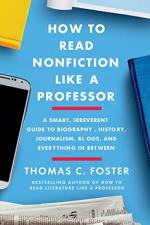
|
| Name: _________________________ | Period: ___________________ |
This test consists of 5 short answer questions, 10 short essay questions, and 1 (of 3) essay topics.
Short Answer Questions
1. In Chapter 7, "All in How You Look at Things," Whome does Foster say is "our greatest living thinker about writing nonfiction" (81)?
2. In Chapter 5, "It May Just Be Me, But..." what does Foster say is true about quotes attributed to anonymous sources?
3. In Chapter 2, "The Ecology of the Nonfiction Biosphere," what does Foster call the rules governing different forms of nonfiction?
4. In Chapter 7, "All in How You Look at Things," what is the purpose of Foster's discussion of structure in Coming into the Country?
5. In Chapter 4, "The Parts You Don't Read," what is a piece of information that Foster says we can infer from the notes?
Short Essay Questions
1. In Chapter 6, "Source Code," what two problems does Foster identify with the use of data as support?
2. Why, in Chapter 2, "The Ecology of the Nonfiction Biosphere," does Foster say that it is both good and bad news that all communication has a "grammar"?
3. On page 21 of Chapter 2, "The Ecology of the Nonfiction Biosphere," Foster says, of Wolfe's Electric Kool-Aid Acid Test, "This is First Contact with Aliens." What does Foster mean by this, and how do we know?
4. In Chapter 5, "It May Just Be Me, But..." how does Foster suggest that a reader can examine the author's use of quotes to determine bias?
5. In Chapter 6, "Source Code," what relationship does Foster point out between reportorial presence and time?
6. In Chapter 8, "Bringing the News," what problem does Foster identify with creating a point of view for All the President's Men, and how do Woodward and Bernstein solve it?
7. In Chapter 3, "The Power of the Prologue," Foster explains the origin of the prologue. What is its origin and how is that origin reflected in today's prologues?
8. In Chapter 6, "Source Code," what does Foster say is the consequence of a "land without gatekeepers" (68)?
9. On page 33 of "Building Blocks of Arguments," Foster compares claims and grounds to two people standing next to one another at a dance and says warrants are what "pins" them together so that they can "go steady." Explain his meaning.
10. In Chapter 1, "The Structure of Nonfiction Information," why does Foster say that focus and telos can change if the structure of a work is changed?
Essay Topics
Write an essay for ONE of the following topics:
Essay Topic 1
In Chapter 6, "Source Code," Foster suggests that as microfiche research is time-consuming and frustrating, writers should use secondary sources such as biographies. Offer an evaluation of this argument. Be sure to consider the assumptions Foster is making about both primary and secondary sources and the applicability of his suggestion to nonfiction in fields outside of history--such as science, sociology, the arts, politics, and so on.
Essay Topic 2
In Chapter 9, "Living the News," Foster discusses the work of Joan Didion. Write an essay in which you describe his tone in this discussion of Didion and then analyze how he creates this tone.
Essay Topic 3
Choose a piece of science writing and evaluate it according to the standards laid out in "Interrogating the Text."
|
This section contains 1,136 words (approx. 4 pages at 300 words per page) |

|




